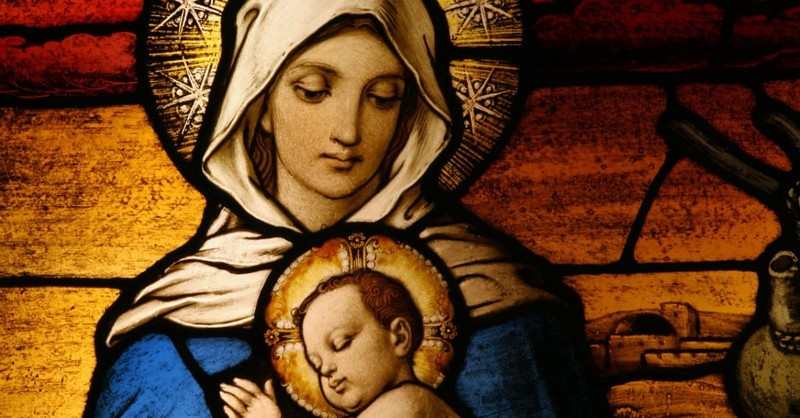Blessed Virgin Mary – Our Queen Mother
By David Cooley.
Among the many beautiful Marian feast days of the Church — such as Mary the Mother of God, the Annunciation, the Assumption and the Immaculate Conception — the feast of Mary’s Queenship, established by Pope Pius XII in 1954, often goes by unnoticed. We celebrated recently celebrated the Queenship of the Blessed Virgin Mary on Aug. 22.
There seems to be a reluctance to apply the title “queen” to the Blessed Virgin. Some seem to think it’s passe, almost a medieval form of praise. On top of that, in America, we are not very familiar or comfortable with kingships and queenships, due to our democratic sensibilities. And the most likely reason for people’s reluctance to claim Mary as our queen is to avoid those misunderstandings among our non-Catholic Christian brothers and sisters. One of the biggest misconceptions about Catholics is that they worship Mary, as opposed to loving and honoring her. Even among theologians it is argued that the title of “queen” evokes more of a Mariology of privilege rather than a Mariology of service.
However, the nature of Mary’s regality is not only rooted in Scripture (both New and Old Testaments), but also has important theological implications that have been explored throughout Church history.
At the Annunciation, Gabriel announced that Mary’s son would receive the throne of David and rule forever. At the Visitation, Elizabeth calls Mary “mother of my Lord.” Christ is king of all creation and Mary is closely associated with her son — her queenship is a share in Jesus’ kingship.
In the Old Testament we have the fascinating figure of the Queen Mother. In ancient times, the mother of an heir to the throne or of a young king had a great influence in the royal court. In the Davidic kingdom, the mother of the king held an official position in which she shared in her son’s reign and served as an advocate for the people and as a counselor for her son. For us we think of a queen as the wife of a king, but the queen mother of Israel was their most powerful, and therefore preferred, advocate. Her specific place of honor and intercession is dramatically illustrated in 1 Kings 2:13-21.
The prophecy of Isaiah 7:14 involves the sign of a queen mother who will conceive and bear the future Davidic King — Immanuel. The queen-mother figure also seems to appear prototypically in Genesis 3:15, which associates a mother and her royal offspring in the context of God’s kingdom.
Applied to Mary, we recognize that she is closely related to Christ’s kingship and her whole being is involved in the spread of his kingdom. In contrast to many historical queen mothers, Mary did not seek the throne for her son because of any personal ambition. Her ministry was one of service, to the point of sacrificing her motherly rights for our sake.
As Queen Mother, Mary never rules in Christ’s stead; she does not command her son, yet it gives him joy to fulfill her wishes. Her authority in the kingdom is authentic but always dependent on the King. (Cf. John 2:5. “Do whatever He tells you.”) Mary’s queenly function consists in interceding on our behalf. It is anchored in her early role as Mother of the Redeemer and Mother of the redeemed.
The feast of Mary’s Queenship is celebrated on the octave day of the feast of the Assumption. The coronation of Mary connects to her Assumption into heaven. While the assumption has been the object of dogmatic definition (1950), the coronation of Mary is a traditional devotion. The coronation points to the Marian title of “queen,” known in Christianity since from the beginning of the fourth century.
Her queenship is an an indication of her excellence based primarily on her role as the Mother of Jesus Christ, “Theotokos,” and as “the all holy one” (“panagia”). As the glorified Jesus remains with us as our king until the end of time (Matt 28:20), so does Mary, who was assumed into heaven and crowned queen of heaven and earth.
The Second Vatican Council, perched on hundreds and hundreds of years of tradition, reaffirmed authoritatively the doctrine of Mary’s queenship: “When her earthly life was over,” she was “exalted by the Lord as Queen over all things, that she might be the more fully conformed to her Son.” (Lumen Gentium n. 59)
The coronation of Mary was the outcome of Mary’s journey of discipleship. At the end of her earthly life, she was borne to the Kingdom of her beloved Son (cf. Col 1:13) and received for her faithfulness “the crown of life.” (Rev 2:10; cf. 1 Cor 9:25) This outcome has universal significance because the Blessed Virgin, now having attained fullness of freedom and full communion with Christ, is the icon of the advance of the Church and of all of history and creation, as it moves forward toward becoming “a new heaven and a new earth” (Rev 21:1; cf. Is 65:17), God’s dwelling, in which “there shall be no more death or mourning, wailing or pain.” (Rev 21:4; cf. Is 25:8)
Pope St. John Paul II saw the Assumption of Mary into heaven as the ultimate exaltation of the noble “Daughter of Zion,” and he associated her assumption with her established queenly position. He states that Christ raises his mother to be eternally glorified as “Queen of the Universe.” We recognize Christ as the ultimate Davidic king — the realization of everything Israel and the whole world could hope for, ushering in the kingdom of God — and by his side is the Queen Mother. And, just as the Queen Mother found in the Old Testament (cf. Jer 13:18; 1 Kg 2:19), was granted the office of sitting beside her king son and mediating on behalf of the people, the Virgin Mary, our Holy Queen, speaks on our behalf to her Son, our King. In this heavenly role, she serves as a protector to us all.
Mary’s Queenship, like her Son’s kingship, is one of love and service, not pomp and power (John 18:36; Matt 20:20). The roots of Mary’s Queenship are to be found in the Paschal Mystery of Christ, which is a mystery of self-giving, death and resurrection and ascension — the reaching of glory through humility.
Hail, Holy Queen!



